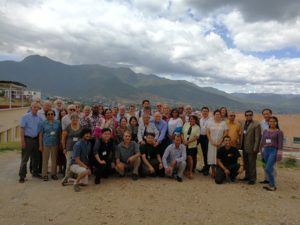Juan Xi, Carmen Garcia-Downing
Field reports and observations of development-induced displacements (DIDR) have long reported health risks associated with DIDR including increased morbidity and mortality. In contrast to studies on wars, political conflicts or disasters, studies of these deleterious health impacts are limited. Some of the studies on health and DIDR have relied on the literature of health impacts on refugees and IDPs. Methodologically, such studies are challenging and complex, but the impacts are likely to be more widespread and intergenerational, as a forced displacement dismantles the physical and cultural infrastructure for coping with illnesses and mental stress. Footnote 2 of the World Bank Operational Policy 4.12, Annex A. Involuntary Resettlement Instruments states:
“Provision of health care services, particularly for pregnant women, infants, and the elderly, may be important during and after relocation to prevent increases in morbidity and mortality due to malnutrition, the psychological stress of being uprooted, and the increased risk of disease.”1
It might be true that this specific group of population might be more vulnerable than the rest of the displaced population but the changes in mental and physical health being measured by field studies show that the forced relocation of peoples to a new social order in a new place, under chaotic circumstances has far broader consequences than what might accompany the loss of health care services. The impact on the physical and emotional well being of the displacees and the host population is present, but its details are largely unknown. A health care risk that may be affecting 15 million people a year begs understanding.
It is therefore imperative that we begin to bring more evidence to the forefront on the health impacts of DIDR. This “hot issues” section offers an opportunity to build a shared bibliography of case studies, research works. A clearer understanding of specific health impacts of DIDR might help project affected peoples (PAPs), communities and project sponsors to implement policies or measures to prevent negative health impacts of DIDR. We hope that it will serve as a platform to highlight some successful efforts in DIDR and health.
We begin by highlighting the pioneering works of Steven K. Ault, Thayer Scudder, Satish Kedia, Juan Xi and others. Thanks to those who have contributed to this list and if you know of other studies please let us know so we can add them to the list by contacting the editors.
Selected Works
Ault, S. K. 1981. The relationship Between Disease and Non-Health Related Development Projects in the Developing World: A Survey of the Literature. APHA. Accessed August 9, 2013 at: http://pdf.usaid.gov/pdf_docs/PNAAJ741.pdf
Cao,Yue, Sean-Shong Hwang, and Juan Xi. 2012. “Project-Induced Displacement, Secondary Stressors, and Health.” Social Science and Medicine 72:1130-38.
Goessling, Kristen. P. 2010 . “Mining Induced Displacement and Mental Health: A Call for Action”, International Journal For The Advancement of Counseling, 32 ( 3): 153-164. Accessed July 22, 2013 at: http://link.springer.com/content/pdf/10.1007%2Fs10447-010-9096-y.pdf
Hwang, Sean-Shong, Yue Cao, and Juan Xi. 2010. “Project-induced Migration and Depression: A Panel Analysis” Social Science and Medicine.70:1765-72.
Hwang, Sean-Shong, Yue Cao, and Juan Xi. 2011. “The Short-Term Social, Economic, and Health Impact of China’s Three Gorges Dam Project: A Prospective Study.” Social Indicators Research 101:73-92.
Kedia, Satish. 2009. “Health Consequences of Dam Construction and Involuntary Resettlement,” Pp97-117 in Development & Dispossession. Edited by Anthony Oliver-Smith. Santa Fe, NM: School for Advanced Research Press.
Lerer, Leonard B., and T. Scudder. 1999. “Health impacts of large dams.” Environmental Impact Assessment Review 19(2): 113-123. Accessed on July 11, 2013 at: http://www.who.int/hia/examples/energy/whohia020/en/index.html
McMichael C, Barnett J, McMichael AJ. 2012. “An ill wind? Climate change, migration, and health.” Environ Health Perspectives. 120(5):646-54.
Schwarz, Maureen Trudelle. 1997. “Unraveling the Anchoring Cord. Navajo Relocation 1974-1996.” American Anthropologist 99 (1): 43-55. Accessed at: www.jstor.org/stable/682132
Winkler MS, Krieger GR, Divall MJ, Cissé G, Wielga M, Singer BH, Tanner M, Utzinger J. 2013. “Untapped potential of health impact assessment.” Bull World Health Organ. 91(4):298-305. doi: 10.2471/BLT.12.112318.
Winkler, Mirko S., Mark J. Divall, Gary R. Krieger, Marci Z. Balge, Burton H. Singer,and Jurg Utzinger. 2010. “Assessing health impacts in complex eco-epidemiological settings in the humid tropics: Advancing tools and methods.” Environmental Impact Assessment Review. 30 (1) : 52-61. Accessed on July 11, 2013 at: http://www.sciencedirect.com/science/article/pii/S0195925509000869
Xi, Juan and Sean-Shong Hwang. 2011. “Relocation Stress, Coping, and Sense of Control among Resettlers Resulting from China’s Three Gorges Dam Project” Social Indicators Research 104: 507-522.
Xi, Juan and Sean-Shong Hwang. 2011. “Unmet Expectations and Symptoms of Depression among the Three Gorges Project Resettlers.” Social Science Research 40:245-56.
Xi, Juan, Sean-Shong Hwang, and Patricia Drentea. 2013. “Experiencing a Forced Relocation at Different Life Stages: the Effects of China’s Three-Gorges Project-Induced Relocation on Depression” Society and Mental Health 3: 69-76.
Editors
Juan Xi, University of Akron
Carmen Garcia-Downing, University of Arizona
August 13, 2013
[1] World Bank OP 4.12, Annex A. Involuntary Resettlement Instruments. December, 2001. Revised February 2011



